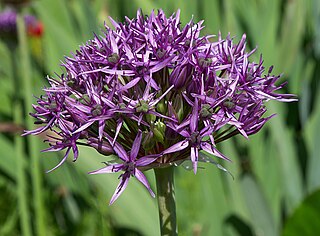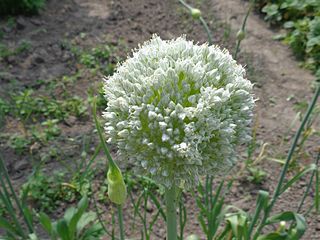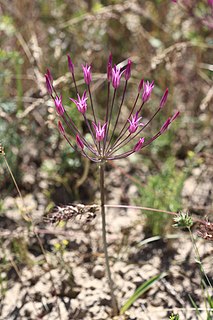
Allium drummondii, also known as Drummond's onion, wild garlic and prairie onion, is a North American species of onion native to the southern Great Plains of North America. It is found in South Dakota, Kansas, Nebraska, Colorado, Oklahoma, Arkansas, Texas, New Mexico, and northeastern Mexico.

Allium canadense, the Canada onion, Canadian garlic, wild garlic, meadow garlic and wild onion is a perennial plant native to eastern North America from Texas to Florida to New Brunswick to Montana. The species is also cultivated in other regions as an ornamental and as a garden culinary herb. The plant is also reportedly naturalized in Cuba.

Allium giganteum, common name giant onion, is an Asian species of onion, native to central and southwestern Asia but cultivated in many countries as a flowering garden plant. It is the tallest species of Allium in common cultivation, growing to 1.5 metres (4.9 ft).
Allium przewalskianum is an Asian species of wild onion in the Amaryllis family.
Allium atrosanguineum an Asian species of onion native to China, Siberia, Mongolia, and Central Asia. It grows high in the mountains at elevations of 2400–5400 m.
Allium fetisowii is a plant species native to Kazakhstan, Uzbekistan, Xinjiang, Kyrgyzstan and Tajikistan in Central Asia.
Allium tschimganicum is a Central Asian species of onion native to Uzbekistan and Kyrgyzstan. The Flora of China regards this name as synonymous with Allium fetisowiiRegel. However, other sources accept A. tschimganicum as a distinct species.
Allium flavovirens is a species of onions endemic to the western part of Inner Mongolia. It grows in dry places at altitudes of 1800–3100 m.
Allium subangulatum is a Chinese species of wild onion, native to Gansu, Ningxia and Qinghai Provinces.
Allium tanguticum is a Chinese species of wild onion native to Gansu, Qinghai and Tibet. It grows at elevations of about 2000–3500 m.
Allium tenuissimum is an Asian species of wild onion native to Mongolia, Asiatic Russia, Korea, Kazakhstan and China.

Allium atropurpureum is a plant species native to Hungary, the Balkans, and Turkey. It is widely grown as an ornamental for its rich, deep purple flowers.

Allium sindjarense is a species of flowering plant in the Amaryllidaceae family.
Allium filidens is a species of onion found at high elevations of central and south-central Asia. It is a bulb-forming perennial up to 45 cm tall, forming a hemispherical umbel of flowers; tepals white or pink with a purple midvein.

Allium akaka is a species of onion native to Iran.

The precise taxonomy of the genus Allium is still poorly understood with incorrect descriptions being widespread. With over 850 species distributed over the Northern hemisphere Allium is the sole genus in the Allieae, one of four tribes of subfamily Allioideae (Amaryllidaceae). New species continue to be described and Allium is both highly variable and one of the largest monocotyledonous genera, but the precise taxonomy of Allium is poorly understood, with incorrect descriptions being widespread. The difficulties arise from the fact that the genus displays considerable polymorphism and has adapted to a wide variety of habitats. Furthermore, traditional classications had been based on homoplasious characteristics. However, the genus has been shown to be monophyletic, containing three major clades, although some proposed subgenera are not. Some progress is being made using molecular phylogenetic methods, and the internal transcribed spacer (ITS) region, including the 5.8S rDNA and the two spacers ITS1 and ITS2, is one of the more commonly used markers in the study of the differentiation of the Allium species.
Allium suworowii is a species of onion native to Afghanistan and Central Asia. It is a widely distributed and highly genetically variable species. It has gained the Royal Horticultural Society's Award of Garden Merit as an ornamental.

Allium iliense is a species of wild onion native to southeastern Kazakhstan. Living in sandy areas, its loose inflorescence can detach when ripe and roll in the wind, spreading seeds much further in the manner of a tumbleweed.

Allium altissimum, the tall onion, is a species of flowering plant in the family Amaryllidaceae, native to Central Asia, Iran, and Afghanistan. Its best-known cultivar is 'Goliath'.









